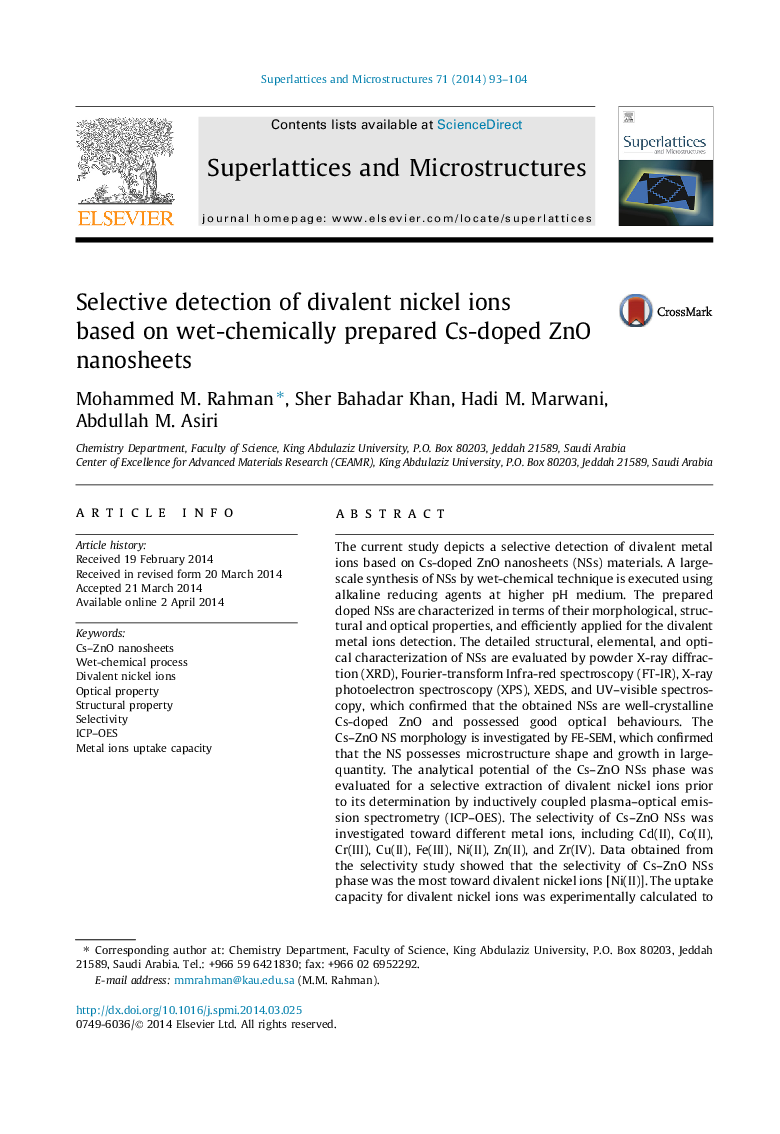| Article ID | Journal | Published Year | Pages | File Type |
|---|---|---|---|---|
| 1553675 | Superlattices and Microstructures | 2014 | 12 Pages |
•Selective detection of divalent nickel ions based on doped Cs-doped ZnO nanosheets.•Cs-doped ZnO NSs used as a Selective Solid Phase Adsorbent.•The static adsorption capacity for Ni(II) was calculated to be 88.85 mg g−1.•Adsorption process was mainly monolayer based onto a surface containing a finite number of adsorption sites.
The current study depicts a selective detection of divalent metal ions based on Cs-doped ZnO nanosheets (NSs) materials. A large-scale synthesis of NSs by wet-chemical technique is executed using alkaline reducing agents at higher pH medium. The prepared doped NSs are characterized in terms of their morphological, structural and optical properties, and efficiently applied for the divalent metal ions detection. The detailed structural, elemental, and optical characterization of NSs are evaluated by powder X-ray diffraction (XRD), Fourier-transform Infra-red spectroscopy (FT-IR), X-ray photoelectron spectroscopy (XPS), XEDS, and UV–visible spectroscopy, which confirmed that the obtained NSs are well-crystalline Cs-doped ZnO and possessed good optical behaviours. The Cs–ZnO NS morphology is investigated by FE-SEM, which confirmed that the NS possesses microstructure shape and growth in large-quantity. The analytical potential of the Cs–ZnO NSs phase was evaluated for a selective extraction of divalent nickel ions prior to its determination by inductively coupled plasma–optical emission spectrometry (ICP–OES). The selectivity of Cs–ZnO NSs was investigated toward different metal ions, including Cd(II), Co(II), Cr(III), Cu(II), Fe(III), Ni(II), Zn(II), and Zr(IV). Data obtained from the selectivity study showed that the selectivity of Cs–ZnO NSs phase was the most toward divalent nickel ions [Ni(II)]. The uptake capacity for divalent nickel ions was experimentally calculated to be ∼88.85 mg g−1. Moreover, adsorption isotherm data of divalent nickel ions on Cs–ZnO NSs phase were well fit with the Langmuir adsorption isotherm, strongly supporting that the adsorption process was mainly monolayer on homogeneous adsorbent surfaces.
Graphical abstractFigure optionsDownload full-size imageDownload as PowerPoint slide
